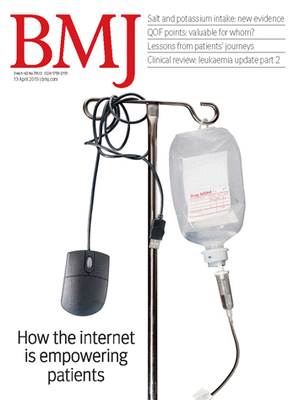
In this week’s BMJ (British Medical Journal), an American patient tells his story about being equipped, enabled, empowered and engaged — the many “e’s” making up the prefix of “ePatient.”
This definition comes out of the work of Dr. Tom Ferguson, who worked with the e-Patient Scholars Working Group in 2007, to publish the first white paper about the phenomenon, e-Patients: how they can help us heal health care.
ePatient Dave is the patient-author of the BMJ piece, making the case for shared decision-making and patient involvement in health care decisions. He writes in the conclusion, “The value delivered by skilled clinicians is still there, but now we can see that it’s no longer the only source—and sometimes it’s not even the best. According to patients. And even according to my oncologist.”
In Dave’s case, patient engagement involved joining the ACOR listserv patient group (the Association of Cancer Online Resources) led by Gilles Frydman. Information gleaned on ACOR led Dave to more effectively learn about his cancer from fellow patients like him, and also helped him better decide on optimal subsequent treatments based on other patients paying it forward by sharing their patient perspectives and cancer details.
Dave continues: “Please, let patients help improve healthcare. Let patients help steer our decisions, strategic and practical. Let patients help define what value in medicine is.”
An introductory essay by Trevor Jackson, deputy editor of the BMJ, is called Patient-Powered Health. In addition to this piece, this issue of BMJ has an instructive article on the magazine’s series from the past seven years, Patient Journeys, and what lessons the first 100 journeys published have revealed. These cover the themes that:
- Sometimes doctors take too long to arrive at a correct diagnosis, but had they read about patients, they might diagnose the condition sooner
- Doctors sometimes don’t understand that certain aspects of a patient’s condition are important to them, unbeknownst to the clinician
- Doctors are sometimes unaware of newer evidence-based treatments that could have helped their patients.
Peter Lapsley, BMJ’s Patient Editor, writes, “This leads us to what may be the most significant lesson of all, the importance of good doctor-patient communication, which needs to be as jargon-free as possible, be empathetic, and bridge educational, social, and age related boundaries. It is good that British medical schools now place so much emphasis on this.”
Health Populi’s Hot Points: What Dr. Tom and Dave and Dr. Danny Sands (head of the Society for Participatory Medicine and one of Dave’s physicians) and a growing cadre of patients and physicians are learning is that patient involvement indeed creates value across many dimensions in health and health care:
- Greater patient engagement yields lower costs, according to research on patient activation by Dr. Judith Hibbard
- Shared decision making drives greater trust between patient and provider
- Greater patient involvement and education can lower risk of malpractice and litigation by patients, among other hard ROI.
I emphasize the last sentence written by Peter Lapsley of the BMJ, who notes that British medical schools are placing greater emphasis on doctor-patient communication. Is this the case in U.S. med schools?
The Wall Street Journal covered this very question a few days ago in the April 10th 2013 issue article called, The Experts: How to Improve Doctor-Patient Communication. Among the various opinions shared, Peter Provonost of Johns Hopkins (who leads patient safety efforts) offers a four word simple mantra: “Listen More, Talk Less.” He expands on this novel concept: “When doctors take the time to listen, the treatment decisions and care plans that they develop will better reflect their patients’ wishes; in turn, those plans are more likely to be followed by patients.”




 Thank you FeedSpot for
Thank you FeedSpot for